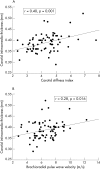Relationship between carotid intima-media thickness and arterial stiffness in children after Kawasaki disease
- PMID: 16820386
- PMCID: PMC2083125
- DOI: 10.1136/adc.2006.096628
Relationship between carotid intima-media thickness and arterial stiffness in children after Kawasaki disease
Abstract
Background: Evidence of premature atherosclerosis and systemic arterial stiffening in patients after Kawasaki disease is accumulating.
Aim: To test the hypothesis that carotid intima-media thickness (IMT), a surrogate marker of atherosclerosis, is associated with systemic arterial stiffness in children after Kawasaki disease.
Methods: A cohort of 72 patients was studied, comprising 26 patients with Kawasaki disease and coronary aneurysms (group I), 24 patients with Kawasaki disease and normal coronary arteries (group II) and 22 healthy age-matched children (group III). The carotid IMT, carotid artery stiffness index, brachioradial pulse wave velocity (PWV), fasting total cholesterol, high-density lipoprotein (HDL) cholesterol and low-density lipoprotein (LDL) cholesterol were determined and compared among the three groups.
Results: The carotid IMT was related to indices of arterial stiffness, and significant determinants of carotid IMT were identified by multivariate analysis. The mean (standard deviation (SD)) carotid IMT of both group I (0.41 (0.04) mm) and group II (0.39 (0.04) mm) was significantly greater than that of group III (0.36 (0.04) mm; p<0.001 and p = 0.008, respectively). For the entire cohort, carotid IMT correlated positively with LDL cholesterol (r = 0.31, p = 0.009), carotid artery stiffness index (r = 0.40, p = 0.001) and brachioradial PWV (r = 0.28, p = 0.016), but not with age, body mass index, systemic blood pressure, and HDL and total cholesterol. Multiple linear regression analysis identified carotid artery stiffness index (beta = 0.25, p = 0.028) and subject grouping (beta = -0.39, p = 0.001; model R(2) = 0.29) as significant correlates of carotid IMT.
Conclusion: The increased carotid IMT in children after Kawasaki disease is associated with systemic arterial stiffening.
Conflict of interest statement
Competing interests: None declared.
Similar articles
-
[The study of vascular lesion using ultrasound in children with a history of Kawasaki disease].Zhonghua Yi Xue Za Zhi. 2007 Aug 14;87(30):2117-20. Zhonghua Yi Xue Za Zhi. 2007. PMID: 17988531 Chinese.
-
Increased high sensitivity C reactive protein concentrations and increased arterial stiffness in children with a history of Kawasaki disease.Heart. 2004 Nov;90(11):1281-5. doi: 10.1136/hrt.2003.018507. Heart. 2004. PMID: 15486121 Free PMC article.
-
Oxidative stress in children late after Kawasaki disease: relationship with carotid atherosclerosis and stiffness.BMC Pediatr. 2008 May 8;8:20. doi: 10.1186/1471-2431-8-20. BMC Pediatr. 2008. PMID: 18466622 Free PMC article.
-
[Investigation of atherosclerosis using carotid ultrasonography].Rinsho Byori. 2010 Aug;58(8):809-15. Rinsho Byori. 2010. PMID: 20860174 Review. Japanese.
-
[Arterial stiffness in pediatric hypertension].Rev Med Chir Soc Med Nat Iasi. 2006 Apr-Jun;110(2):259-66. Rev Med Chir Soc Med Nat Iasi. 2006. PMID: 17802929 Review. Romanian.
Cited by
-
Positive Echocardiographic Association between Carotid Artery and Coronary Artery Diameter and Z-Score in a Mouse Model of Kawasaki Disease.Diagnostics (Basel). 2024 Jan 8;14(2):145. doi: 10.3390/diagnostics14020145. Diagnostics (Basel). 2024. PMID: 38248023 Free PMC article.
-
Inhibition of transforming growth factor β worsens elastin degradation in a murine model of Kawasaki disease.Am J Pathol. 2011 Mar;178(3):1210-20. doi: 10.1016/j.ajpath.2010.11.054. Am J Pathol. 2011. PMID: 21356372 Free PMC article.
-
A Review on Atherosclerotic Biology, Wall Stiffness, Physics of Elasticity, and Its Ultrasound-Based Measurement.Curr Atheroscler Rep. 2016 Dec;18(12):83. doi: 10.1007/s11883-016-0635-9. Curr Atheroscler Rep. 2016. PMID: 27830569 Review.
-
When children with Kawasaki disease grow up: Myocardial and vascular complications in adulthood.J Am Coll Cardiol. 2009 Nov 17;54(21):1911-20. doi: 10.1016/j.jacc.2009.04.102. J Am Coll Cardiol. 2009. PMID: 19909870 Free PMC article. Review.
-
Orthostatic and Exercise Effects in Children Years After Kawasaki Disease.Pediatr Cardiol. 2020 Jan;41(1):24-30. doi: 10.1007/s00246-019-02216-x. Epub 2019 Oct 8. Pediatr Cardiol. 2020. PMID: 31595326
References
MeSH terms
Substances
LinkOut - more resources
Full Text Sources
Other Literature Sources
Medical


